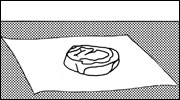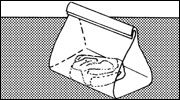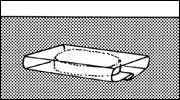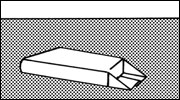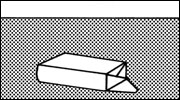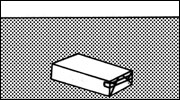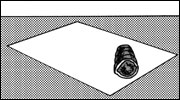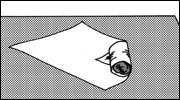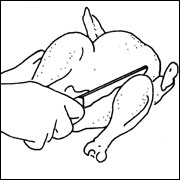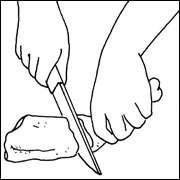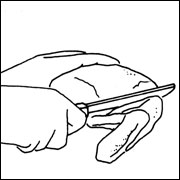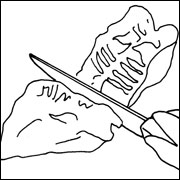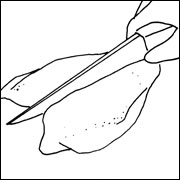Freezing is an excellent method of preserving animal products. Follow these basic guidelines to make freezing simple and effective:
- Choose only fresh, high-quality foods for freezing. Freezing does not improve quality.
- Animal products are extremely perishable, so hold them in the refrigerator until actual preparation for freezing begins. Work quickly so that foods remain chilled during preparation for freezing.
- Freezing does not kill spoilage organisms in food; it simply stops their multiplication. Organisms will continue to grow and multiply once the food begins to thaw. Therefore, the number of bacteria in and on foods must be held to a minimum before freezing. To accomplish this, keep food and everything that touches it — hands, equipment and work surfaces — extremely clean.
- After handling raw meat, fish or poultry, wash hands, cutting surfaces and utensils with hot, soapy water. Laundry bleach can be used as a disinfectant for dishes, cutting surfaces and utensils. Follow package directions carefully to avoid skin, eye and respiratory irritation.
- Protect all foods to be frozen by wrapping or packaging carefully in moisture-vapor-proof containers or wrap.
- Freeze animal products immediately after preparation. Place packages in the coldest part of the freezer, and leave enough space between packages so that the cold air circulates well. Freeze only the amount of fresh meat or poultry that will freeze within 24 hours, about 2 to 3 pounds for each cubic foot of freezer space.
- Maintain a temperature of 0° F in a home freezer. Do not let the temperature fluctuate.
- For safety and best quality, thaw all animal products in the refrigerator. Cook or use meat, poultry or fish immediately; use eggs within one to two days and dairy products within a few days.
Refer to MU Extension publication GH1501, Freezing Basics, for detailed information on the freezing process and recommended storage times.
Red meats: beef, veal, lamb or pork
If you are inexperienced butchering meat, have a professional meat cutter slaughter your animal, cut it into serving pieces, and quick freeze it for you. If you want to do everything yourself, refer to MU Extension publication G2208, Home Slaughtering and Processing of Beef.
Packaging
Freeze meat in meal-sized packages. Remove as many bones as possible because they take up freezer space. Prevent off-flavors by trimming excess fat, which will become rancid.
When packing several cuts in one package, put two layers of freezer paper between the pieces. This layering makes it easy to separate pieces for fast thawing (Figure 1).
The store wrap on purchased meats is not meant for long-term freezer storage. Meat frozen in store wrap will suffer freezer burn in a few weeks. Freezer burn occurs when air dries the meat and causes loss of flavor. Rewrap or overwrap purchased meats that will be kept frozen longer than two weeks.
Precautions with cured and cooked meats
Cured meats
Salt increases the rate at which rancidity develops in meat. For this reason, bacon and cured hams have an extremely short freezer life and should be used within one month. Freezing is not recommended for hot dogs and luncheon meats because their emulsion will be broken and the product will “weep.”
Cooked meats
Cooked meat will dry out much faster than fresh meat in the freezer if it is not covered with some kind of sauce, gravy or broth. The liquid fills up the air spaces and prevents drying by protecting the meat from exposure to the air. Cooked meats frozen in liquid should be kept a shorter time than fresh meats — no longer than three months.
Poultry
Select plump, unblemished and odorless poultry for freezing.
Choose poultry according to your use. Tender young birds are best for roasting, frying and broiling, whereas the more flavorful birds, usually labeled for stewing, are best for braising or stewing.
Whole birds are always the best buys. Although buying parts is more convenient, you are paying someone else for cutting up the poultry. You can save money by purchasing whole birds and learning the simple task of cutting them up yourself (Figure 2).
Freeze poultry in the form you intend to use it: whole, halved or cut up. When freezing cut-up pieces, put a double layer of freezer paper between pieces or halves for easy separation and faster thawing. When packaging pieces, arrange them to form a compact, square, flat package so that they will stack better in the freezer. Package and freeze giblets separately because they have a shorter shelf life and cannot be stored as long as light or dark meat.
Because of the irregular shape of poultry parts, freezer bags are easier to use than wrap. It is important to get all the air out of freezer bags in which poultry is stored. Even small air pockets can cause freezer burn. The best way to get out most of the air is to plunge the bag into a pan of water to force all the air to the top. Quickly twist the top end and seal.
The store wrap on purchased poultry is not meant for long-term freezer storage. Poultry frozen in store wrap will suffer freezer burn in a few weeks. Rewrap or overwrap purchased poultry to be held longer than two weeks. Commercially wrapped frozen poultry, such as turkey, does not need to be rewrapped.
Caution
Do not stuff poultry before freezing it. During freezing and thawing, food poisoning bacteria can easily grow in the stuffing. Commercially stuffed frozen poultry is fast frozen under conditions that cannot be duplicated at home.
Fish
Fish deteriorates rapidly and should be cleaned and frozen soon after it is caught. If you cannot freeze fish right away, pack it in crushed ice until it can be frozen.
Preparation
This process can be challenging, access step by step video by the Missouri Department of Conservation at https://huntfish.mdc.mo.gov/fishing/get-started-fishing/ cleaning-and-prepping-fish.
Wash fish in drinking-quality water, and remove scales by scraping fish gently from tail to head with the dull edge of a knife.
Remove entrails after cutting entire length of belly from vent to head. Remove head by cutting above collarbone. Break backbone over edge of cutting board or table.
Remove dorsal fins, the large back fins, by cutting flesh along each side and pulling fin out. Never trim fins off with shears or a knife because bones at the base of fin will be left in fish.
Wash fish thoroughly in cold running water. The fish is now dressed or pan dressed, depending on size. Large fish should be steaked or filleted for easier cooking.
For steaks: Cut fish crosswise into 3/4-inch thick steaks.
To fillet: With a sharp knife, cut down back of fish from tail to head. Then cut down to backbone just above collarbone. Turn knife flat and cut flesh along backbone to tail, allowing knife to run over rib bones. Lift off entire side of fish in one piece, freeing fillet at tail. Turn fish over and cut fillet from other side.
Pretreating
Fish are categorized as either fat or lean fish based on the amount of fat in their flesh. Fat fish includes varieties such as mullet, mackerel, trout, tuna and salmon. Lean fish includes flounder, cod, whiting, redfish, croaker, snapper, grouper, sheepshead and most freshwater fish, such as bass, crappie, and catfish.
Before freezing, fish need to be pretreated to improve the quality of the stored fish. Fat fish should be dipped for 20 seconds in an ascorbic acid solution made from 2 teaspoons of crystalline ascorbic acid to 1 quart of cold water to decrease rancidity and flavor change. Lean fish may be dipped for 20 seconds in a brine of ¼ cup salt to 1 quart of cold water to firm the fish and decrease drip loss on thawing.
Packaging
Fish may be frozen using any of these methods:
Wrap: Place pretreated fish in a moisture-vapor-proof wrap. Insert a double piece of freezer paper between fillets to make separation easier.
Water: Place fish in a shallow metal, foil or plastic pan; cover with water; and freeze. To prevent evaporation of the ice, wrap the container in freezer paper after it is frozen.
Ice glaze: Place unwrapped fish in the freezer to freeze. As soon as it is frozen, dip fish in near-freezing ice water. Place fish in the freezer again for a few minutes to harden the glaze. Remove the fish from the freezer, and repeat the glazing until a uniform cover of ice is formed. Wrap the fish in moisture-vapor-proof paper or place in freezer bags.
Fish roe (eggs)
Roe is the most perishable fish product. It should be frozen separately.
Thoroughly wash each set of roe from extremely fresh fish. Pierce the egg sac in several places with a sterilized needle. Give all roe, whether from lean or fat fish, a 20-second dip in a solution of 2 teaspoons crystalline ascorbic acid dissolved in 1 quart of cold water to lessen the chance of rancidity and flavor change during storage.
Wrap each set of roe in plastic film wrap for easy separation when frozen, smoothing out all air. Pack in flat layers in rigid freezer containers, seal and freeze. Use roe within 3 months.
Small and large game, and game birds
Rabbit, squirrel and other small game should be skinned, dressed and chilled as soon as possible after shooting. Refrigerate for 24 to 36 hours until meat is no longer rigid. Cut into serving pieces or leave whole, depending on how you intend to use it in meals.
Deer, moose, antelope and other large game should be field dressed and safely processed to prevent spoilage. Then the meat can be handled for freezing like any other meat or carcass. Trim and discard bloodshot meat before freezing.
Quail, dove, duck, geese, pheasant and other game birds should be bled, gutted and chilled as soon as possible after shooting. Remove excess fat on wild ducks and geese, as it becomes rancid quickly. Process and freeze the same as for domestic poultry.
Thawing meat, poultry and fish
To prevent the growth of spoilage organisms, thaw meat, poultry and fish in the refrigerator. Some meats, such as large roasts, should be at least partially thawed before cooking to prevent them from becoming overdone on the outside before the inside is cooked. Meat, poultry or fish to be floured or breaded before cooking should be partially thawed so the coating will stick to the surface.
Cooking frozen meat, poultry or fish
Most meat, poultry or fish can be cooked frozen if extra cooking time is allowed. Cooking frozen meats takes from 11/3 to 1½ times as long as cooking fresh meat, depending on the size of the cut. Quality is similar between thawed meats and frozen meats cooked by the same method and to the same degree of doneness. However, it takes longer cooking time to cook frozen meats.
Table 1. Poultry refrigerator thawing guide.
| Poultry | Weight | Thawing time |
|---|---|---|
| Chickens | 4 pounds or heavier | 1 to 1-1/2 days 12 to 16 hours |
| Ducks | 3 to 7 pounds | 1 to 1-1/2 days |
| Geese | 6 to 12 pounds | 1 to 2 days |
| Turkeys | 4 to 12 pounds | 1 to 2 days |
| 12 to 20 pounds | 2 to 3 days | |
| 20 to 24 pounds | 3 to 4 days | |
| Pieces of large turkey (half, quarter, half breast) | 1 to 2 days | |
| Cut-up pieces | 3 to 9 hours | |
| Boneless roasts | 12 to 18 hours | |
Useful guidelines for cooking frozen meat
- When roasting frozen meat, poultry or fish in an oven, lower the temperature by 25 degrees and increase the roasting time by half. Use a meat thermometer to check the degree of doneness of larger cuts. Wait until the meat is partially thawed before inserting the thermometer.
- When broiling frozen meat, poultry or fish, place it about 5 to 6 inches from the heat. This distance is farther than for unfrozen meats. Increase broiling time by half.
- To pan broil or fry frozen meat, poultry or fish, start with a hot skillet for thin cuts and a warm skillet for thick cuts. After the meat is thawed, turn up the heat.
Eggs
Eggs can be stored for 2 to 3 weeks covered in the refrigerator, so freezing is usually unnecessary. If you have an excess of fresh eggs, however, freezing is the best way to preserve them. They cannot be frozen in the shell because expansion of the white and yolk will cause the shell to break. Hard-cooked eggs cannot be frozen because the white becomes rubbery. The recommended length of freezer storage for frozen eggs is 9 to 12 months.
Select fresh, chilled eggs, and break each separately into a clean saucer. Examine each egg for freshness, and remove any pieces of shell before mixing with other eggs. Eggs with blood specks are safe to eat; removing the specks is optional. Freeze eggs in amounts that will be used in recipes. It is necessary to add sugar or salt to whole eggs or yolks before freezing to prevent gumminess.
Whole eggs
Stir eggs with a fork to break yolks and mix them well with the whites. Do not whip in air. Add 1½ teaspoons sugar or ½ teaspoon salt for each cup of whole eggs. Package, leave headspace, seal and freeze. Date and label package with quantity and amount of sugar or salt added.
A convenient method of freezing whole egg mixture is to measure 3 tablespoons of egg mixture into each compartment of a clean ice tray. Freeze until solid. Remove frozen cubes, package in moisture-vapor-proof containers, seal and return to freezer immediately. One cube of the egg mixture equals one whole egg.
Egg yolks
Separate eggs. Stir yolks with a fork to break them. Add 2 teaspoons sugar or 1 teaspoon salt for each cup of egg yolks. Package, leave headspace, seal and freeze. Label package with quantity and amount of sugar or salt added.
Egg whites
Strain whites through a sieve. Do not add sugar or salt. Package, leave headspace, seal and freeze without stirring.
Thawing and preparation
Frozen eggs should be thawed in the refrigerator and used within 1 to 2 days. They can be used exactly like freshly broken eggs in baked products, casseroles or egg dishes. Be sure to account for the extra sugar and salt added to the eggs before freezing.
Approximate equivalents for large eggs:
- 1 whole egg = 3 tablespoons whole egg mixture
- 1 yolk = 1 tablespoon yolk
- 1 white = 2 tablespoons white
- 5 whole eggs = 1 cup whole mixed eggs
- 10 whole eggs = 1 pint (2 cups) whole mixed eggs
- 16 whites = 1 pint (2 cups) stirred whites
- 16 yolks = 1/2 pint (1 cup) stirred yolks
Dairy foods
Butter
Freeze only high-quality butter made from pasteurized cream. Mold into squares, patties or other desired shapes. Use moisture-vapor-proof freezer wrap or containers to keep butter from absorbing odors and to prevent freezer burn. Butter in its original carton can be overwrapped. One-pound blocks can be cut into smaller portions that can be used in a short time. Wrap tightly in moisture-vaporproof wrap, label and freeze. Thaw in the refrigerator, and use within a few days.
Cheese
Processed and natural cheeses such as cheddar, Edam, Gouda, Swiss and brick freeze well.
- Blocks should be 1 pound or less and no more than 1 inch thick.
- Package in heavy-duty aluminum foil, plastic freezer paper with freezer tape, or freezer bags.
- Thaw in the refrigerator.
Frozen cheese has a tendency to dry out and become crumbly, so use in cooking for best results.
Cottage cheese
Only uncreamed (dry) cottage cheese should be frozen. Creamed cottage cheese is mushy after freezing.
Thaw all forms of cheese in the refrigerator, and use within a few days.
Cream
Freeze only pasteurized cream containing at least 40 percent butterfat. Cream can be frozen whipped or unwhipped; however, it often does not whip after being frozen. Freeze dollops of sweetened whipped cream on a baking sheet. When frozen, package in freezer bags. To thaw, place on dessert just before serving.
Before freezing liquid cream, heat it to 170° F for 10 to 15 minutes. Add 1/3 cup of sugar for each quart, pour into rigid containers, leave headspace, seal and freeze. Liquid cream that has been frozen is suitable for use in cooking or in coffee. Thaw in refrigerator, and use within a few days.
Ice cream
Commercial ice cream can be stored in the freezer for several months. Cover with plastic wrap or foil after each use to prevent it from drying out or becoming gummy. For longer storage, repackage in moisture-vapor-proof freezer containers or overwrap with freezer bags. See MU Extension publication GH1505, How to Freeze Home-Prepared Foods, for information on homemade ice cream.
Milk
Only pasteurized milk should be frozen. Pour into moisture-vapor-proof containers and leave adequate headspace. During the freezing process, the water in milk rises to the surface and forms ice. This separation affects the flavor and appearance of milk, and it is difficult to thoroughly remix the water and milk solids after thawing. Milk that has been frozen can be used for cooking and baking. Thaw milk in the refrigerator, and use within a few days.
Yogurt
Flavored yogurt freezes better than plain yogurt. When thawed, plain yogurt may taste more acidic. Package in freezer containers, seal and freeze.
Dairy products that do not freeze well
These products separate or become mushy after thawing:
- Whipped butter
- Buttermilk
- Cream cheese
- Creamed cottage cheese
- Sour cream (sour cream can be frozen successfully when combined with other ingredients and frozen in prepared food)
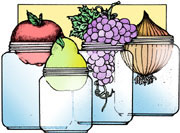 Developed by Barbara Willenberg
Developed by Barbara Willenberg